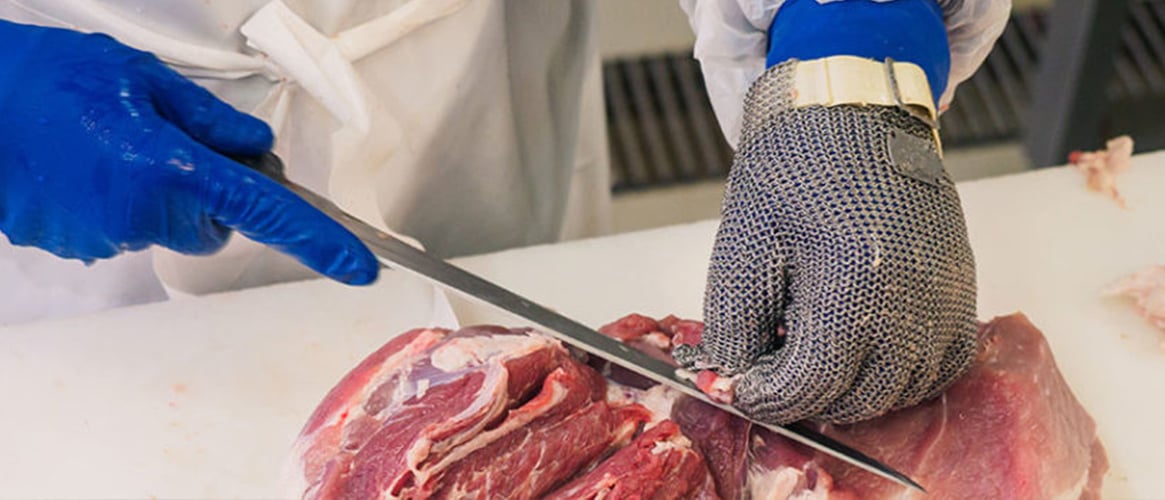Cuts, lacerations, and punctures are common injuries in the meat packing and butchering industry. Knives, slicers, grinders, and sharp bones are all potential hazards that can be minimized with the use of personal protective equipment (PPE), safe work practices, and inspections.
Safe knife handling starts with what you wear
Personal protective equipment (PPE) to prevent cuts and punctures starts with sturdy work shoes to protect your feet when a knife or other sharp object may fall to the ground. Aprons can protect your upper legs and torso from accidental cuts and slices while you work. Gauntlets can protect your arms. Cut-resistant butcher’s gloves, typically made of mesh or Kevlar®, protect your hands. Latex or nitrile gloves can be worn over and under the cut-resistant gloves to help them stay sanitary, last longer, and improve your grip while you work.
13 knife safety steps
Not all knives are created equal. Boning, butchering, sticking, and breaking knives all have different uses. This means the blades for each are different. Remember to wash and dry your hands before using a knife and then follow these tips:
- Keep your knives properly sharpened so they can slice through meats and not slip accidentally.
- Inspect, maintain, and replace your knives, blades, and other sharp tools as needed.
- Always cut away from your body.
- Use a cutting board or other surface, never try to cut or filet an item in your hand.
- Use a meat holder fork or prong to stabilize the meat as you cut it.
- Carry a knife with the blade down and pointed away from you.
- If passing the knife to someone else, put the knife down on a clean surface and let them pick it up.
- Don’t be rushed as you cut and try to keep distractions at a minimum. If you are interrupted when using a knife, place the knife down, do not continue cutting while distracted.
- If you drop your knife, never try to catch it while it falls. Let it drop.
- Don’t place knives or other sharp objects in your pockets, belt, or belt loops.
- Sheath and store your knives properly. Don’t store knives and sharp tools loose in a drawer.
- Place knives and sharp tools at the back of your work surface; don’t keep them near the edge where they can be knocked off.
- If you place knives in a sink, place them into a designated wash basin. Never reach into a soapy sink with your bare hands if you cannot see under the water. Enclosed baskets can be used to store knives and mesh gloves can be used for washing and sterilization.
Slicers and grinders
Meat grinders and slicers can cause severe injuries, amputations, and even death if they are not used properly. Always inspect the slicer and grinders prior to use. Discard any damaged, broken, or worn-out equipment. Make sure all guards and safety devices are in place. Use lockout/tag out procedures for cleaning, servicing, adjusting, repairs, changing parts, maintenance and to clear jams and ensure proper PPE is worn, such as hand protection.
When using a slicer or grinder, be aware of where your hands are. Ensure the slicer or grinder is at the correct setting before you turn it on. Use the appropriate size food pushers; never use your hands to process food through grinders and slicers. Under no circumstance should a pusher be used in lieu of guarding. Keep your fingers and hands away from the moving parts and blades at all times. Never reach across the blade or grinder. Tie hair back, remove dangling jewelry, and wear form-fitting clothing to prevent getting pulled into the equipment.
Always operate equipment according to the manufacturer’s instructions. Turn off and unplug the slicers and/or grinders when not in use or left unattended, and don’t forget to switch the thickness dial of the meat slicer to zero.
Only use slicers and grinders on flat, stable, and clutter free surfaces.
Properly maintained equipment, safe work practices, and safety training can help prevent cuts, lacerations, and punctures in the workplace.
